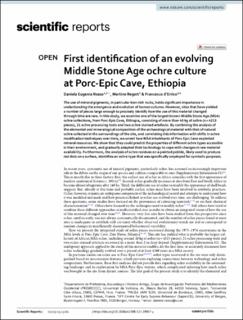| dc.contributor.author | Rosso, Daniela Eugenia | |
| dc.contributor.author | Regert, Martine | |
| dc.contributor.author | d'Errico, Francesco | |
| dc.date.accessioned | 2023-09-19T12:05:09Z | |
| dc.date.available | 2023-09-19T12:05:09Z | |
| dc.date.created | 2023-09-16T05:39:13Z | |
| dc.date.issued | 2023 | |
| dc.identifier.issn | 2045-2322 | |
| dc.identifier.uri | https://hdl.handle.net/11250/3090446 | |
| dc.description.abstract | The use of mineral pigments, in particular iron-rich rocks, holds significant importance in understanding the emergence and evolution of human cultures. However, sites that have yielded a number of pieces large enough to precisely identify how the use of this material changed through time are rare. In this study, we examine one of the largest known Middle Stone Age (MSA) ochre collections, from Porc-Epic Cave, Ethiopia, consisting of more than 40 kg of ochre (n = 4213 pieces), 21 ochre processing tools and two ochre-stained artefacts. By combining the analysis of the elemental and mineralogical composition of the archaeological material with that of natural ochre collected in the surroundings of the site, and correlating this information with shifts in ochre modification techniques over time, we unveil how MSA inhabitants of Porc-Epic Cave exploited mineral resources. We show that they could predict the properties of different ochre types accessible in their environment, and gradually adapted their technology to cope with changes in raw material availability. Furthermore, the analysis of ochre residues on a painted pebble, likely used to produce red dots on a surface, identifies an ochre type that was specifically employed for symbolic purposes. | en_US |
| dc.language.iso | eng | en_US |
| dc.publisher | Nature | en_US |
| dc.rights | Navngivelse 4.0 Internasjonal | * |
| dc.rights.uri | http://creativecommons.org/licenses/by/4.0/deed.no | * |
| dc.title | First identification of an evolving Middle Stone Age ochre culture at Porc-Epic Cave, Ethiopia | en_US |
| dc.type | Journal article | en_US |
| dc.type | Peer reviewed | en_US |
| dc.description.version | publishedVersion | en_US |
| dc.rights.holder | Copyright 2023 The Author(s) | en_US |
| dc.source.articlenumber | 13261 | en_US |
| cristin.ispublished | true | |
| cristin.fulltext | original | |
| cristin.qualitycode | 1 | |
| dc.identifier.doi | 10.1038/s41598-023-39957-y | |
| dc.identifier.cristin | 2175716 | |
| dc.source.journal | Scientific Reports | en_US |
| dc.relation.project | Norges forskningsråd: 262618 | en_US |
| dc.identifier.citation | Scientific Reports. 2023, 13, 13261. | en_US |
| dc.source.volume | 13 | en_US |

